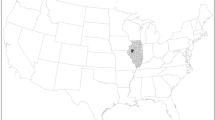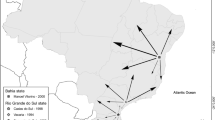Abstract
Populations of introduced European wild boar, feral pigs, and combinations of both types (all Susscrola L.) inhabit thirteen areas in the National Park Service system. All parks have relatively stable populations, with the exception of Great Smoky Mountains National Park, which reported a rapidly expanding wild boar population. Suspected and documented impacts were apparently related to pig densities and sensitivity of the ecosystem; the three largest units with dense wild pig populations reported the most damage. Overall, wild pigs are a relatively minor problem for the Park Service; however, problems are severe in at least three parks, and there is potential for invasion of wild boars into several additional parks in the Appalachian Mountains. More specific information is needed on numbers of wild pigs and their impacts in the various parks.
Similar content being viewed by others
Literature cited
Andrzejewski, R., and W. Jezierski. 1978. Management of a wild boar population and its effects on commercial land.Acta Theriologica 23:309–339.
Baber, D. W. 1978. Social organization and behavior in the feral hog,Sus scrofa L. Unpubl. M.S. Thesis, Fla. Inst. of Tech., 66 pp.
Baker, J. K. 1979. The feral pig in Hawaii Volcanoes National Park. Pages 365–367in R. M. Linn, ed. Proc. 1st Conf. on Sci. Research in the National Parks. U.S. Dept. Interior, National Park Serv. Trans. and Proc. Series 5. Wash., D.C.
Baron, J. S. 1979. Vegetation damage by feral hogs on Horn Island, Gulf Islands National Seashore, Mississippi. Unpubl. M.S. Thesis, Univ. Wisconsin, Madison. 124 pp.
Barrett, R. H. 1978. The feral hog on the Dye Creek Ranch, California.Hilgardia 46:283–355.
Barrett, R. H. 1977. Wild pigs in California. Pages 111–113in G. W. Wood, ed. Research and management of wild hog populations. Belle W. Baruch For. Sci. Inst., Georgetown, S.C.
Beiden, R. C., and M. R. Pelton. 1975. European wild hog rooting in the mountains of east Tennessee. Proc. Southeastern Assoc. Game Fish Comm. 20:139–145.
Blocker, J. C. von. 1937. The mammals of Monterey Country, California. Unpubl. Ph.D. Thesis, Univ. California, Berkeley. 338 pp. (Cited in Barrett 1978: not seen by author).
Bratton, S. P. 1974. The effect of the European wild boar (Sus scrofa) on high-elevation vernal flora in the Great Smoky Mountains National Park.Bull. Torrey Bot. Club 101:198–206.
Bratton, S. P. 1975. The effect of the European wild boar (Sus scrofa) on gray beech forest in the Great Smoky Mountains.Ecology 56:1356–1366.
Bratton, S. P., F. J. Singer, M. E. Harmon, and P. S. White. In press. Rooting impacts of European wild boar during a poor mast year in Great Smoky Mountains National Park. Proc. 2nd Conf. on Sci. Research in the National Parks, Nov. 25–30, 1979, San Francisco.
Briederman, L. 1971. Zur reproduktion des Schwarzwildes in der Deutschen Demokratischen Republik. Tag.-Ber. dt. Akad. Landwirtsch,-Wiss. Berlin 113:169–186.
Brisbin, I. L., M. W. Smith, and M. H. Smith. 1977. Feral swine studies at the Savannah River Ecology Laboratory: an overview of program goals and design. Pages 71–90in G. W. Wood, ed. Research and management of wild hog populations. Belle W. Baruch For. Sci. Inst., Georgetown, S.C.
Caughley, G. 1970. Eruption of ungulate populations with emphasis on Himalayan thar in New Zealand.Ecology 51:53–72.
Caughley, G. 1977. Wildlife management and the dynamics of ungulate populations. Pages 183–246in T. H. Croaker, ed.Advances in applied biology I. Acad. Press, New York.
Caughley, G., and L. C. Birch. 1971. Rate of increase.J. Wildl. Manage. 35:658–663.
Challies, C. N. 1975. Feral pigs (Sus scrofa) on Auckland Island: status, and effects on vegetation and nesting sea birds.New Zealand J. Zool. 2:479–490.
Conley, R. H. 1977. Management and research of the European wild hog in Tennessee. Pages 67–70in G. W. Wood, ed. Research and management of wild hog populations. Belle W. Baruch For. Sci. Instit., Georgetown, S.C.
Conley, R. H., V. G. Henry, and G. H. Matschke. 1972. European wild hog research project W-34. Tennessee Game and Fish Comm. Final Rep. 259 pp.
Decker, E. 1978. Exotics. Pages 249–256in J. L. Schmidt and D. L. Gilbert, eds.Big Game in North America. Stackpole Books, Harrisburg, Pa.
de Vos, A. V., and A. Sassani. 1977. Eine study der population des schwarzwilde (Sus scrofa) in dem Mohammad Reza Shah National Park.Z. Jagdwiss 23:113–126.
Donaurov, S. S., and V. P. Teplov. 1938. Kaban Kaukazskim Zapovednike.Kabazskigo Gosudarstvennogo Zapovednika. 1:191–226.
Duncan, R. W. 1974. Reproductive biology of the European wild hog (Sus scrofa) in the Great Smoky Mountains National Park. Unpubl. M.S. Thesis, Univ. Tennessee. 95 pp.
Giffin, J. G. 1975. Population density of feral pigs in representative rain forests on the island of Hawaii. P-R Rep., Proj. No. W-15-5, Job IV-G. Hawaii Div. Fish and Game.
Haber, A. 1969. Dzik. Warsw: Panstw. Wyd. Roln: Lesn. 215 pp.
Hanson, R. P. and L. Karstad. 1959. Feral swine in the southeastern United States.J. Wildl. Manage. 23:64–74.
Harested, A. S., and F. L. Bunnell. 1979. Home range and body weight — a reevaluation.Ecology 60:389–402.
Henry, V. G. 1966. European wild hog hunting seasons based on reproductive data. Proc. Southeast Assoc. Game Fish Comm. 20:139–145.
Heptner, V. G., A. A. Nasimovich, and A. G. Bannikov. 1966.Die Saugetiere der Sowjetunion. Band 1: Paarhufer and Unpaarhufer. VEB Gustav Fischer Verlag, Jena, DPR. 939 pp.
Huff, M. In press. The effect of rooting by European wild boar on woody vegetation in Great Smoky Mountains National Park. Proc. 2nd Conf. on Sci. Research in the National Parks, Nov. 25–30, 1979, San Francisco.
Jarman, P. J., and K. A. Johnson. 1977. Exotic mammals, indigenous mammals, and land use. Proc. Ecol. Soc. of Australia. 10:146–166.
Jezierski, W. and A. Myrcha. 1975. Food requirements of a wild boar population.Polish Ecol. Studies 1:61–83.
Kozlo, P. G. 1970. Factors determining the population density of the wild boar in the Belovezhskaya Puschcha (in Russian, English summary).Zool. Zhur. 49:422–430.
Kurz, J. C., and R. L. Marchinton. 1972. Radiotelemetry studies of feral hogs in South Carolina.J Wildl. Manage. 36:1240–1248.
Ling, H. 1955. Metssea (Sus scrofa) areaalipiiri muutused Nokogude Baltimaadel Viimastel Sajanditel (Eastonian). Loodus. Selts. Aast. 48:176–200 (cited in Barrett 1978; not seen by author).
Munzel, E. 1971.Der Saupark bei Springe. Stuttgart: DRW-Verlag. 147 pp.
Nasimovich, A. A. 1955. Rol Rezhima Snezhoga Tokpova V Zhizni Kopytnkh Zhivotnyka na Territorii SSR. Izdatestvo Akademii Hauk SSR. Mosckva Pages 288–297.
Oloff, H. B. 1951. Zur biologie and okologie des Wildschweines. Beitrage zur tierkunde und tierzucht Band 2. Verlag Dr. Paul Schors, Frankfurt. 95 pp.
Pine, D. S. and G. L. Gerdes. 1973. Wild pigs in Monterey County, California.Calif. Fish Game 59:126–137.
Poffenberger, D. L. 1979. An investigation of the movements of feral swine (Sus scrofa) in east central Florida. M.S. Thesis, Florida Institute of Technology.
Pucek, Z., B. Bobek, L. Labudzki, L. Mitkowski, K. Murow, and A. Tomek. 1975. Estimates of density and number of ungulates.Polish Ecol. Studies 1:121–135.
Ramsey, C. 1968. Texotic line-up.Texas Parks and Wildl. 25:3–7.
Rary, J. M., V. G. Henry, G. H. Matschke, and R. L. Murphee. 1969. The cytogenetics of swine in the Tellico Wildlife Management Area, Tennessee.J. Heredity 59:201–204.
Riney, T. 1964. The impact of introductions of large herbivores on the tropical environment.IUCN Publ., new series No. 4:261–273.
Sanderson, G. C. 1966. The study of mammal movements — a review.J. Wildl. Manage. 30:215–235.
Singer, F. J., D. K. Otto, A. R. Tipton, and C. P. Hable. In press. Home ranges, movements, and habitat use of European wild boar.J. Wildl. Manage.
Sludskii, A. A. 1956. The wild boar: its ecology and economic importance. Izdatel'svo Akademii Nauk Kazakhskoi SSR, Alma-Ata, 219 pp. (CSIRO transl. from Russian).
Springer, M. D. 1977. Ecological and economic aspects of wild hogs in Texas. Pages 37–46in G. W. Wood, ed. Research and management of wild hog populations. Belle W. Baruch For. Sci. Instit., Georgetown, S.C.
Stegeman, L. C. 1938. The European wild boar in the Cherokee National Forest, Tennessee.J. Mammal. 19:279–290.
Stubbe, W., and M. Stubbe. 1977. Verleichende beitrage zur reproduktions — und geburtsbiologie von wild — und hausschwein (Sus scrofa L.).Beitrage zur Jagd — und Wildforschung 10:153–179.
Sweeney, J. M., J. R. Sweeney, and E. E. Provost. 1978. Reproductive biology of a feral pig population.J. Wildl. Manage. 43:555–559.
Towne, C. W., and E. N. Wentworth. 1950.Pigs from cave to combelt. Univ. of Oklahoma Press, Norman. 305 pp.
Wolfe, J. A. 1967. Forest soil characteristics as influenced by vegetation and bedrock in spruce-fir zone of the Great Smoky Mountains. Unpubl. Ph.D. Thesis, Univ. of Tennessee, Knoxville. 117 pp.
Wood, G. W., and R. E. Brenneman. 1977. Research and management of feral hogs on Hobcaw Barony. Pages 23–35in G. W. Wood, ed. Research and management of wild hog populations. Belle W. Baruch For. Sci. Instit., Georgetown, S.C.
Wood, G. W., and T. E. Lynn, Jr. 1977. Wild hogs in southern forests.South. J. Appl. For. 1:12–17.
Wood, G. W., and R. H. Barrett. 1979. Status of wild pigs in the United States.Wildl. Soc. Bull. 7:237–246.
Author information
Authors and Affiliations
Rights and permissions
About this article
Cite this article
Singer, F.J. Wild pig populations in the National Parks. Environmental Management 5, 263–270 (1981). https://doi.org/10.1007/BF01873285
Issue Date:
DOI: https://doi.org/10.1007/BF01873285




